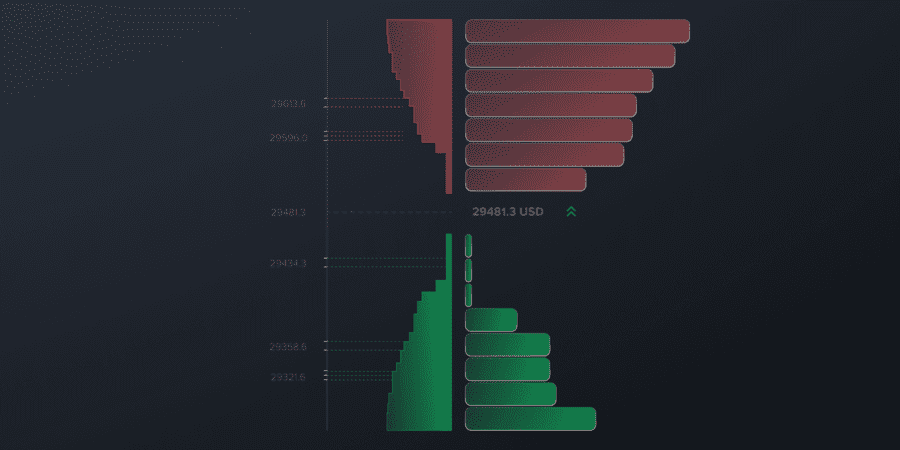
สเปรดในการเทรดคืออะไร และทำงานอย่างไร?
เนื้อหา
ในการซื้อขาย สเปรดคือความผันแปรระหว่างราคาเสนอซื้อและราคาเสนอขาย ซึ่งเป็นตัวกำหนดต้นทุนการทำธุรกรรม แนวคิดพื้นฐานนี้มีผลต่อทุกธุรกรรม ซึ่งส่งผลต่อโอกาสในการทำกำไรและต้นทุนการเปิดสถานะ สำหรับเทรดเดอร์ ความรู้เกี่ยวกับสเปรดเป็นสิ่งสำคัญอย่างยิ่ง เพราะจะส่งผลโดยตรงต่อ กลยุทธ์การซื้อขาย และผลลัพธ์โดยไม่ต้องสำรวจพลวัตของตลาดที่ซับซ้อน
การกำหนด Bid Ask Spread
ในโลกของการซื้อขายทางการเงิน สเปรดเป็นแนวคิดสำคัญที่มีอิทธิพลอย่างมากต่อต้นทุนการซื้อขาย โดยแสดงให้เห็นถึงความผันแปรระหว่างราคาเสนอซื้อและราคาเสนอขาย ซึ่งเป็นสองราคาที่สำคัญในตลาดการเงินใดๆ ก็ตาม ในขณะที่ราคาเสนอขายคือราคาต่ำสุดที่ผู้ขายพร้อมจะยอมรับ ส่วนราคาเสนอซื้อคือราคาสูงสุดที่ผู้บริโภคในตลาดพร้อมจะจ่ายสำหรับสินค้าโภคภัณฑ์บางชนิด สเปรดนี้สะท้อนสภาพคล่องของสินทรัพย์ สภาวะตลาด และต้นทุนทางตรงที่ผู้ซื้อขายจ่ายเมื่อทำธุรกรรม ซึ่งไม่ใช่เพียงส่วนต่างของราคาพื้นฐาน
ประเภทของสเปรด
สเปรดเสนอซื้อ-เสนอขาย
มักพบเห็นได้บ่อยในธุรกรรมตลาดทุกประเภท ส่วนต่างราคาเสนอซื้อ-เสนอขาย (bid-ask spread) ถือเป็นพื้นฐานสำคัญในการทำความเข้าใจพลวัตของตลาด โดยเฉพาะอย่างยิ่งในตลาดที่มีปริมาณการซื้อขายสูง ซึ่งรวมถึงหลักทรัพย์ที่ได้รับความนิยมในตลาดหุ้น หรือตลาดที่มีการจับคู่สกุลเงินจำนวนมาก การซื้อขายฟอเร็กซ์ สเปรดนี้แสดงให้เห็นถึงสภาพคล่องของสินทรัพย์ได้ทันที สเปรดระหว่างราคาเสนอซื้อและเสนอขายที่น้อยกว่ามักบ่งชี้ว่าตลาดมีสภาพคล่องมากกว่าและมีกิจกรรมการซื้อขายมากมาย ในทางตรงกันข้าม สเปรดที่กว้างกว่าบ่งชี้ว่าสภาพคล่องต่ำกว่าและต้นทุนการทำธุรกรรมสูงกว่า
สเปรดแบบคงที่และแบบแปรผัน
ผู้ซื้อขายจะพบกับสเปรดหลักๆ สองประเภทในการเดินทางซื้อขายของพวกเขา:
- สเปรดคงที่- สเปรดเหล่านี้มีค่าคงที่โดยไม่ขึ้นอยู่กับสภาวะตลาดหรือช่วงเวลาของวัน มีประโยชน์อย่างยิ่งในตลาดที่มีความผันผวนน้อยหรือสำหรับกลยุทธ์ที่อิงราคาสเปรดคงที่ ซึ่งให้ความน่าเชื่อถือและความสม่ำเสมอ สเปรดคงที่มักเป็นที่นิยมในหมู่เทรดเดอร์ที่ต้องคาดการณ์ค่าธรรมเนียมการซื้อขายอย่างแม่นยำ
- สเปรดแบบแปรผัน- สเปรดแบบผันแปรจะเปลี่ยนแปลงไปตามสภาวะตลาดปัจจุบัน ซึ่งแตกต่างจากสเปรดแบบคงที่ แม้ว่าช่วงเวลาที่มีสภาพคล่องสูงมักจะสั้นกว่า แต่ความผันผวนที่รุนแรงหรือข่าวเศรษฐกิจที่สำคัญอาจทำให้สเปรดขยายตัวอย่างมาก สเปรดประเภทนี้สะท้อนถึงอุปทานและอุปสงค์แบบเรียลไทม์ในตลาด
บทบาทของสเปรดในตลาดการเงิน
ภายในโครงสร้างที่ซับซ้อนของตลาดการเงิน สเปรดไม่ได้เป็นเพียงแค่สถิติเท่านั้น แต่ยังเป็นองค์ประกอบที่จำเป็นในการรักษาความอยู่รอดพื้นฐานของตลาด ผู้เข้าร่วมหลักที่รักษา สภาพคล่องของตลาด โบรกเกอร์และผู้ดูแลสภาพคล่องส่วนใหญ่มักพึ่งพาสเปรดเป็นแหล่งรายได้หลัก ผู้ดูแลสภาพคล่องมักตั้งราคาเสนอซื้อและเสนอขายสินทรัพย์โดยเจตนา ดังนั้นจึงมีอิทธิพลต่อสเปรดตามการประเมินสภาพตลาด สเปรดนี้ไม่ใช่แบบสุ่ม แต่เป็นการจ่ายความเสี่ยงที่เกิดขึ้นจากการให้สภาพคล่องคงที่แก่ตลาด
สำหรับเทรดเดอร์ สเปรดเป็นองค์ประกอบสำคัญที่ต้องพิจารณาในกิจกรรมการซื้อขายของพวกเขา สเปรดมีอิทธิพลโดยตรงต่อการดำเนินการซื้อขาย ส่งผลกระทบทั้งเวลาเข้าและออกจากตลาด ขนาดของสเปรดมีความสำคัญอย่างยิ่ง เนื่องจากเป็นตัวกำหนดการเคลื่อนไหวขั้นต่ำที่ราคาสินทรัพย์ต้องเคลื่อนไหวเพื่อให้การซื้อขายถึงจุดคุ้มทุน สเปรดที่กว้างขึ้นหมายความว่าราคาตลาดจำเป็นต้องเคลื่อนไหวอย่างมีนัยสำคัญมากขึ้นในทิศทางที่เทรดเดอร์ต้องการเพื่อทำกำไร จึงมีอิทธิพลอย่างมากต่อกระบวนการตัดสินใจของเทรดเดอร์ สิ่งนี้ทำให้สเปรดเป็นปัจจัยพื้นฐานในการกำหนดกลยุทธ์การซื้อขายและการประเมิน ความเสี่ยงที่อาจเกิดขึ้น -
ดังนั้น การรู้ค่าสเปรดจึงไม่เพียงแต่เป็นส่วนประกอบหนึ่งของค่าใช้จ่ายในการซื้อขายเท่านั้น แต่ยังสะท้อนถึงปัจจัยต่างๆ ในตลาด เช่น สภาพคล่อง ความผันผวน และกิจกรรมของผู้ดูแลสภาพคล่อง ผลกระทบของค่าสเปรดจะแทรกซึมทุกแง่มุมของการซื้อขาย ตั้งแต่การกำหนดกลยุทธ์ครั้งแรก ไปจนถึงการดำเนินการซื้อขายครั้งสุดท้าย และแม้กระทั่งผลกำไรขั้นสุดท้าย กล่าวโดยสรุป ค่าสเปรดเป็นแง่มุมที่หลากหลายของตลาดการเงินที่เทรดเดอร์ต้องเชี่ยวชาญเพื่อนำทางตลาดอย่างมีประสิทธิภาพและเสริมสร้างความสำเร็จในการเทรด
การคำนวณสเปรด
แม้ว่าค่าสเปรดอาจคำนวณได้ค่อนข้างง่าย แต่ขั้นตอนอาจแตกต่างกันไปขึ้นอยู่กับตลาด โดยพื้นฐานแล้ว ค่าสเปรดคำนวณโดยการหักราคาเสนอซื้อ (ซึ่งก็คือจำนวนเงินที่ผู้ซื้อพร้อมจะจ่ายสำหรับสินทรัพย์) ออกจากราคาเสนอขาย (ซึ่งก็คือราคาที่ผู้ขายพร้อมจะรับ) เทรดเดอร์ต้องคำนึงถึงส่วนต่างของราคานี้ทั้งเมื่อเข้าและออกจากตลาด ราคาเสนอซื้อจะน้อยกว่าราคาเสนอขายเสมอ ค่าสเปรดแสดงถึงความต่างระหว่างจุดราคาทั้งสองนี้
ในกรอบการซื้อขาย Forex ซึ่งตลาดมีการซื้อขายคึกคักมาก ค่าสเปรด (Spread) จึงเป็นตัวชี้วัดสภาพคล่องของคู่สกุลเงินที่สำคัญ คู่สกุลเงินหลักอย่าง EUR/USD มักมีค่าสเปรดที่น้อยกว่าเนื่องจากมีสภาพคล่องและปริมาณการซื้อขายสูง ค่าสเปรดที่จำกัดบ่งชี้ว่าอุปสงค์และอุปทานในตลาดมีความสมดุล เนื่องจากราคาซื้อและราคาขายใกล้เคียงกัน ซึ่งเป็นประโยชน์ต่อเทรดเดอร์ เนื่องจากบ่งชี้ถึงโอกาสในการทำกำไรที่สูงขึ้นและค่าใช้จ่ายในการทำธุรกรรมที่ลดลง
ในทางกลับกัน คู่สกุลเงินที่มีการซื้อขายน้อยกว่าหรือคู่สกุลเงินแปลกใหม่มักจะมีสเปรดที่สูงกว่า ความเสี่ยงที่สูงขึ้นและสภาพคล่องที่น้อยกว่าในคู่สกุลเงินเหล่านี้ส่งผลให้สเปรดที่สูงกว่า ซึ่งส่งผลให้ค่าใช้จ่ายในการซื้อขายสูงขึ้น บ่อยครั้งที่ปริมาณการซื้อขายที่น้อยลงและความสนใจในคู่สกุลเงินนั้นๆ ที่น้อยลง ช่องว่างที่มากขึ้นระหว่างคู่สกุลเงินบ่งชี้ถึงความแตกต่างอย่างเห็นได้ชัดระหว่างราคาที่ผู้ซื้อพร้อมจ่ายและผู้ขายพร้อมรับ
ขนาดของสเปรดสะท้อนถึงความเสี่ยงและความผันผวนของตลาดได้มากพอๆ กับสภาพคล่อง โดยทั่วไปสเปรดอาจกว้างขึ้นในช่วงเวลาที่มีความไม่แน่นอนหรือเกิดการเปลี่ยนแปลงทางเศรษฐกิจครั้งใหญ่ เมื่อผู้ดูแลสภาพคล่องปรับราคาเสนอซื้อและเสนอขายเพื่อสะท้อนถึงความน่าจะเป็นที่สูงขึ้นของการเปลี่ยนแปลงราคาอย่างรวดเร็ว
ปัจจัยที่มีอิทธิพลต่อการแพร่กระจาย
ในสภาพตลาดที่เปลี่ยนแปลงตลอดเวลา ค่าสเปรดไม่ใช่ตัวเลขคงที่ แต่กลับเป็นค่าที่ได้รับผลกระทบจากปัจจัยหลายอย่าง ปัจจัยเหล่านี้อาจส่งผลกระทบอย่างมากต่อค่าสเปรด ซึ่งส่งผลต่อกลยุทธ์การซื้อขายและต้นทุนการซื้อขาย สำหรับเทรดเดอร์ การรู้ว่าปัจจัยใดที่มีอิทธิพลต่อความผันแปรของค่าสเปรดจึงเป็นสิ่งสำคัญ เพราะจะช่วยให้สามารถคาดการณ์การเคลื่อนไหวของตลาดและปรับเปลี่ยนแผนการซื้อขายได้ ในบทความนี้ เราจะมาสำรวจปัจจัยหลักที่ส่งผลต่อค่าสเปรด ได้แก่ สภาพคล่องของตลาด ความผันผวน และปัจจัยสำคัญอื่นๆ
สภาพคล่องของตลาด
การทำความเข้าใจกลไกพื้นฐานของค่าสเปรดในการซื้อขายส่วนใหญ่ขึ้นอยู่กับแนวคิดเรื่องสภาพคล่อง กล่าวโดยสรุปคือ สภาพคล่องคือความง่ายในการซื้อหรือขายสินทรัพย์หนึ่งชิ้นในตลาดในราคาใกล้เคียงกับมูลค่าตลาด สินทรัพย์อาจถูกขายได้อย่างรวดเร็วและมีประสิทธิภาพในตลาดที่มีสภาพคล่องสูงและปริมาณการซื้อขายสูง ซึ่งทำให้ค่าสเปรดแคบลง เนื่องจากผู้ขายและผู้ซื้อจำนวนมากมั่นใจว่าธุรกรรมต่างๆ จะสามารถดำเนินการได้โดยไม่ส่งผลกระทบต่อราคาของสินทรัพย์อย่างมีนัยสำคัญ ตัวอย่างเช่น คู่สกุลเงินหลักในตลาด Forex มีสภาพคล่องสูงกว่า ส่งผลให้ค่าสเปรดแคบลง ต้นทุนค่าสเปรดที่ลดลงนี้เป็นประโยชน์ต่อเทรดเดอร์โดยหมายถึงต้นทุนการเข้าและออกจากการซื้อขายที่ลดลง ทำให้ตลาดที่มีสภาพคล่องสูงน่าสนใจสำหรับ การซื้อขายบ่อยครั้ง -
You may also like

ความผันผวนของตลาด
องค์ประกอบสำคัญอีกประการหนึ่งที่มีผลต่อค่าสเปรดคือความผันผวน ซึ่งแสดงถึงอัตราการเปลี่ยนแปลงของราคาตลาดของสินทรัพย์สำหรับชุดผลตอบแทนที่กำหนด ในช่วงเวลาที่มีความผันผวนสูง ราคาจะเคลื่อนไหวอย่างรวดเร็วและรุนแรงในช่วงเวลาสั้นๆ ผู้ดูแลสภาพคล่องจะตกอยู่ในอันตรายเนื่องจากความผันผวนนี้ เขาตอบสนองโดยการเพิ่มค่าสเปรด สำหรับผู้ดูแลสภาพคล่อง ค่าสเปรดที่มากขึ้นในช่วงที่มีความผันผวนจะทำหน้าที่เป็นตัวรองรับความผันผวนของราคาอย่างรวดเร็วและเห็นได้ชัดระหว่างเวลาที่ทำการซื้อขายและเสร็จสิ้น พฤติกรรมนี้มักพบเห็นได้ในช่วงเหตุการณ์ทางเศรษฐกิจครั้งใหญ่ วิกฤตการณ์ทางภูมิรัฐศาสตร์ หรือการประกาศสำคัญของบริษัทต่างๆ เมื่อความไม่แน่นอนก่อให้เกิดความผันผวนในตลาด
ปัจจัยที่มีอิทธิพลอื่น ๆ
นอกเหนือจากสภาพคล่องและความผันผวนแล้ว ยังมีปัจจัยอื่นๆ อีกหลายประการที่สามารถส่งผลต่อสเปรดในการซื้อขายได้:
- เวลาและช่วงการซื้อขาย: เมื่อตลาดการเงินโลกเปิดและปิด ค่าสเปรดอาจเปลี่ยนแปลงได้ตลอดทั้งวัน ตัวอย่างเช่น ในการซื้อขายฟอเร็กซ์ ช่วงเวลาการซื้อขายที่สำคัญๆ เช่น ช่วงลอนดอนและนิวยอร์ก มักส่งผลให้มีสภาพคล่องมากขึ้นและค่าสเปรดแคบลง
- เหตุการณ์และข่าวสารทางเศรษฐกิจ: การประกาศทางเศรษฐกิจที่นำมาซึ่งความไม่แน่นอนและความผันผวนที่อาจเกิดขึ้น เช่น การตัดสินใจเกี่ยวกับอัตราดอกเบี้ย สถิติการจ้างงาน และข้อมูลเงินเฟ้อ อาจทำให้ค่าสเปรดเพิ่มขึ้น หลายครั้งที่เทรดเดอร์ติดตามปฏิทินเศรษฐกิจอย่างใกล้ชิดเพื่อคาดการณ์ความผันแปรของค่าสเปรด
การทราบองค์ประกอบเหล่านี้ทำให้ผู้ซื้อขายสามารถคาดการณ์การเปลี่ยนแปลงของสเปรดและวางแผนการซื้อขายที่เหมาะสมได้ จึงมั่นใจได้ว่าแผนจะตรงกับสถานการณ์ปัจจุบันในตลาด
สเปรดและผลกระทบต่อการซื้อขาย
ค่าสเปรด ซึ่งมักถูกมองว่าเป็นเพียงส่วนต่างระหว่างราคาสองราคาในการซื้อขาย แท้จริงแล้วมีความสำคัญอย่างยิ่ง โดยเฉพาะอย่างยิ่งเมื่อพิจารณาถึงต้นทุนที่เกี่ยวข้องกับการซื้อขาย โดยพื้นฐานแล้ว ค่าสเปรดเป็นค่าธรรมเนียมพื้นฐานที่เทรดเดอร์ต้องเผชิญทุกครั้งที่ทำการซื้อขาย ค่าธรรมเนียมนี้เป็นส่วนสำคัญของกระบวนการซื้อขาย โดยมีผลต่อการเข้า (ราคาซื้อ) และการออก (ราคาขาย) ของการซื้อขาย
ทำความเข้าใจเกี่ยวกับสเปรดในฐานะต้นทุนการทำธุรกรรม
เทรดเดอร์ต้องเผชิญกับต้นทุนค่าสเปรดทันทีเมื่อเริ่มทำธุรกรรม ยกตัวอย่างเช่น ในการเทรด Forex เทรดเดอร์จะซื้อสกุลเงินคู่หนึ่งที่ราคาเสนอขาย (Ask price) และต้องการให้ราคาตลาดขยับขึ้นอย่างน้อยเท่ากับส่วนต่างของสเปรดเพื่อให้จุดคุ้มทุน ในทางกลับกัน เมื่อขาย พวกเขาต้องรับมือกับราคาเสนอขาย ซึ่งมักจะต่ำกว่าราคาตลาดเล็กน้อย ส่วนต่างนี้ หรือที่เรียกว่าสเปรด (Spread) ส่งผลกระทบต่อผลกำไรโดยรวมของธุรกรรม และโดยพื้นฐานแล้วคือต้นทุนที่เทรดเดอร์ต้องจ่ายเพื่อเข้าสู่ตลาด
การเปรียบเทียบสเปรดระหว่างโบรกเกอร์และแพลตฟอร์ม
การเปรียบเทียบค่าสเปรดที่โบรกเกอร์และระบบเทรดต่างๆ นำเสนอเป็นหนึ่งในวิธีที่เทรดเดอร์สามารถควบคุมและลดค่าใช้จ่ายได้ โบรกเกอร์แต่ละรายอาจมีค่าสเปรดที่แตกต่างกันไป ขึ้นอยู่กับกลุ่มเป้าหมาย สภาวะตลาด และกลยุทธ์ทางธุรกิจ โบรกเกอร์บางรายอาจเสนอค่าสเปรดที่แข่งขันได้อย่างสม่ำเสมอ ซึ่งอาจเป็นประโยชน์ต่อเทรดเดอร์ที่ให้ความสำคัญกับต้นทุนการทำธุรกรรมที่ต่ำลง อย่างไรก็ตาม สิ่งสำคัญที่เทรดเดอร์ควรพิจารณาคือค่าสเปรดและค่าธรรมเนียมหรือค่าคอมมิชชั่นแยกต่างหากที่อาจเกิดขึ้น
ยกตัวอย่างเช่น โบรกเกอร์ที่มีสเปรดแคบ อาจเรียกเก็บค่าธรรมเนียมการซื้อขายแยกต่างหาก ซึ่งจะชดเชยค่าใช้จ่ายในการซื้อขายทั้งหมด ในทางกลับกัน โบรกเกอร์ที่มีสเปรดสูงกว่าเล็กน้อยแต่ไม่มีค่าใช้จ่ายในการซื้อขายเพิ่มเติม อาจเป็นทางเลือกที่คุ้มค่ากว่า ไม่ว่าจะเป็นเดย์เทรด สเกลปิ้ง สวิงเทรด หรือเทคนิคการซื้อขายอื่นๆ เทรดเดอร์ต้องประเมินค่าใช้จ่ายเหล่านี้โดยพิจารณาจากปริมาณการซื้อขายและวิธีการซื้อขาย
ต้นทุนสเปรดในสภาวะตลาดที่แตกต่างกัน
ผลกระทบของค่าสเปรดต่อต้นทุนอาจแตกต่างกันไปตามสภาวะตลาด ค่าสเปรดมักจะลดลงในช่วงที่ความผันผวนของตลาดลดลง ซึ่งจะช่วยลดต้นทุนการทำธุรกรรม ในทางกลับกัน ค่าสเปรดอาจเพิ่มขึ้นอย่างมากในช่วงที่มีความผันผวนสูงหรือมีข่าวเศรษฐกิจขนาดใหญ่ ความผันผวนของต้นทุนค่าสเปรดนี้ส่งผลต่อความสามารถในการทำกำไรของวิธีการซื้อขาย โดยเฉพาะอย่างยิ่งวิธีการซื้อขายที่ขึ้นอยู่กับการแกว่งตัวของราคาเพียงเล็กน้อย
ค่าใช้จ่ายในการเทรดส่วนใหญ่ประกอบด้วยค่าสเปรด ซึ่งเทรดเดอร์ต้องพิจารณาในทุกธุรกรรม การทำความเข้าใจโครงสร้างของค่าสเปรด การเปรียบเทียบข้อเสนอจากโบรกเกอร์และแพลตฟอร์มต่างๆ และการจับคู่กลยุทธ์การเทรดให้สอดคล้องกับสถานการณ์ตลาดปัจจุบัน จะช่วยให้เทรดเดอร์บริหารจัดการได้อย่างมีประสิทธิภาพและอาจช่วยลดค่าใช้จ่ายในการเทรดได้ ความสำเร็จในระยะยาวในสภาพแวดล้อมทางการเงินที่เปลี่ยนแปลงตลอดเวลาขึ้นอยู่กับความรอบคอบทางการเงินนี้
ผลกระทบของเทคโนโลยีต่อการซื้อขายแบบสเปรด
พลวัตของสเปรดได้รับการเปลี่ยนแปลงอย่างมากจากความก้าวหน้าทางเทคโนโลยีของอุตสาหกรรมการเงิน การพัฒนาแพลตฟอร์มการซื้อขายออนไลน์และระบบการซื้อขายอัตโนมัติได้เปลี่ยนแปลงภูมิทัศน์การซื้อขายด้วยการเพิ่มประสิทธิภาพของตลาดและลดสเปรด
อิทธิพลของแพลตฟอร์มการซื้อขายออนไลน์
เทคโนโลยีการซื้อขายออนไลน์ได้เปลี่ยนแปลงการเข้าถึงตลาด ระบบเหล่านี้ช่วยให้เทรดเดอร์สามารถติดตามราคาและค่าสเปรดแบบเรียลไทม์สำหรับสินค้าทางการเงินมากมาย รวมถึงสินค้าโภคภัณฑ์ ฟอเร็กซ์ และหุ้น จึงช่วยส่งเสริมความโปร่งใส การมองเห็นและการเข้าถึงที่มากขึ้นนี้ช่วยส่งเสริมสภาพแวดล้อมการแข่งขันในหมู่โบรกเกอร์ ทำให้พวกเขาจำเป็นต้องเสนอค่าสเปรดที่แคบลงเพื่อดึงดูดและรักษาเทรดเดอร์ไว้ ความสะดวกในการเปรียบเทียบค่าสเปรดระหว่างแพลตฟอร์มต่างๆ ทำให้เทรดเดอร์สามารถตัดสินใจได้อย่างชาญฉลาดมากขึ้น จึงสร้างแรงกดดันให้โบรกเกอร์ต้องรักษาค่าสเปรดให้สามารถแข่งขันได้อย่างสม่ำเสมอ
You may also like

บทบาทของระบบการซื้อขายอัตโนมัติ
ระบบซื้อขายอัตโนมัติก็มีบทบาทสำคัญในการมีอิทธิพลต่อค่าสเปรดเช่นกัน ระบบเหล่านี้ซึ่งใช้อัลกอริทึมในการดำเนินการซื้อขาย สามารถประมวลผลธุรกรรมปริมาณมากได้อย่างรวดเร็วและมีประสิทธิภาพ ประสิทธิภาพนี้ช่วยเพิ่มสภาพคล่องในตลาด นำไปสู่ค่าสเปรดที่แคบลง ระบบอัตโนมัติสามารถตอบสนองต่อความเคลื่อนไหวในตลาดได้ทันที โดยใช้ประโยชน์จากโอกาสของค่าสเปรดที่จำกัด ซึ่งอาจจะสั้นเกินไปสำหรับการเทรดส่วนบุคคล สิ่งนี้สร้างบรรยากาศที่สามารถปรับค่าสเปรดให้เหมาะสมแบบเรียลไทม์ ซึ่งสอดคล้องกับสถานการณ์ตลาดปัจจุบัน
การบูรณาการเทคโนโลยีในการซื้อขายช่วยลดค่าสเปรดและสร้างความเท่าเทียมในการเข้าถึงตลาดต่างๆ ส่งผลให้ผู้เล่นสามารถมีส่วนร่วมในกิจกรรมการซื้อขายได้มากขึ้น เมื่อเทคโนโลยีพัฒนาขึ้น อิทธิพลของเทคโนโลยีที่มีต่อพลวัตของตลาด ซึ่งรวมถึงการกำหนดและจัดการค่าสเปรด คาดว่าจะเพิ่มมากขึ้น ส่งผลให้เทรดเดอร์มีเครื่องมือและโอกาสในการซื้อขายที่ซับซ้อนมากขึ้น
บทสรุป
สเปรดเป็นแนวคิดพื้นฐานในการเทรด ซึ่งเป็นส่วนหนึ่งของการทำความเข้าใจพลวัตของตลาดและต้นทุนการทำธุรกรรม ตั้งแต่ฟอเร็กซ์ไปจนถึงการเทรดหุ้น ความสามารถของเทรดเดอร์ในการวิเคราะห์สเปรดได้อย่างมีประสิทธิภาพสามารถมีอิทธิพลอย่างมากต่อความสำเร็จในการเทรดของพวกเขา เมื่อสภาวะตลาดเปลี่ยนแปลงไป กลยุทธ์ของเทรดเดอร์ในการจัดการสเปรดก็เปลี่ยนแปลงตามไปด้วย ทำให้การเรียนรู้และปรับตัวอย่างต่อเนื่องเป็นกุญแจสำคัญสู่ความเชี่ยวชาญในการเทรด
อัปเดต:
18 ธันวาคม 2567



